Related Research Articles

Albrecht Dürer, sometimes spelt in English as Durer or Duerer, was a German painter, printmaker, and theorist of the German Renaissance. Born in Nuremberg, Dürer established his reputation and influence across Europe when he was in his twenties due to his high-quality woodcut prints. He was in communication with the major Italian artists of his time, including Raphael, Giovanni Bellini and Leonardo da Vinci, and from 1512 was patronized by Emperor Maximilian I. Dürer is commemorated by both the Lutheran and Episcopal Churches.
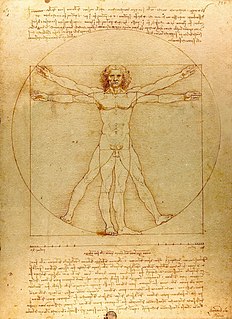
Drawing is a form of visual art in which one uses various drawing instruments to mark paper or another two-dimensional medium. Instruments include graphite pencils, pen and ink, various kinds of paints, inked brushes, colored pencils, crayons, charcoal, chalk, pastels, various kinds of erasers, markers, styluses, and various metals. Digital drawing is the act of using a computer to draw. Common methods of digital drawing include a stylus or finger on a touchscreen device, stylus- or finger-to-touchpad, or in some cases, a mouse. There are many digital art programs and devices.

Leonardo da Vinci was an Italian polymath of the High Renaissance who is widely considered one of the greatest painters of all time. The Mona Lisa is the most famous of his works and the most famous portrait ever made. The Last Supper is the most reproduced religious painting of all time and his Vitruvian Man drawing is also regarded as a cultural icon. He is also known for his notebooks, in which he made drawings and notes on science and invention; these involve a variety of subjects including anatomy, cartography, painting, and palaeontology. Leonardo's collective works compose a contribution to later generations of artists rivalled only by that of his contemporary Michelangelo.

Renaissance art is the painting, sculpture and decorative arts of the period of European history, emerging as a distinct style in Italy in about 1400, in parallel with developments which occurred in philosophy, literature, music, science and technology. Renaissance art, perceived as the noblest of ancient traditions, took as its foundation the art of Classical antiquity, but transformed that tradition by absorbing recent developments in the art of Northern Europe and by applying contemporary scientific knowledge. Renaissance art, with Renaissance humanist philosophy, spread throughout Europe, affecting both artists and their patrons with the development of new techniques and new artistic sensibilities. Renaissance art marks the transition of Europe from the medieval period to the Early Modern age.
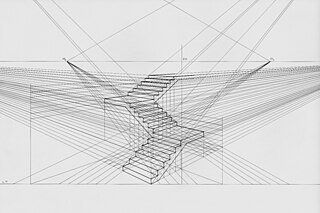
Linear or point-projection perspective is one of two types of graphical projection perspective in the graphic arts; the other is parallel projection. Linear perspective is an approximate representation, generally on a flat surface, of an image as it is seen by the eye. The most characteristic features of linear perspective are that objects appear smaller as their distance from the observer increases, and that they are subject to foreshortening, meaning that an object's dimensions along the line of sight appear shorter than its dimensions across the line of sight. All objects will recede to points in the distance, usually along the horizon line, but also above and below the horizon line depending on the view used.
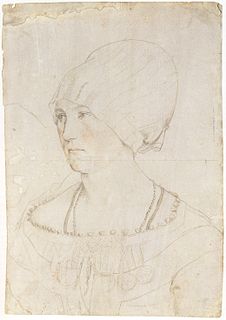
Silverpoint is a traditional drawing technique first used by medieval scribes on manuscripts.

The Virgin of the Rocks is the name of two paintings by the Italian artist Leonardo da Vinci, of the same subject, with a composition which is identical except for several significant details. The version generally considered the prime version, the earlier of the two, is unrestored and hangs in the Louvre in Paris. The other, which was restored between 2008–2010, hangs in the National Gallery, London. The paintings are both nearly 2 metres high and are painted in oils. Both were originally painted on wooden panels, but the Louvre version has been transferred to canvas.
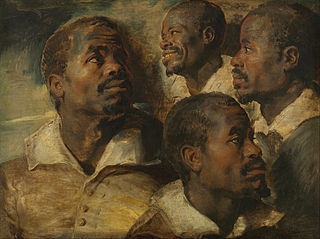
In art, a study is a drawing, sketch or painting done in preparation for a finished piece, or as visual notes. Studies are often used to understand the problems involved in rendering subjects and to plan the elements to be used in finished works, such as light, color, form, perspective and composition. Studies can have more impact than more-elaborately planned work, due to the fresh insights the artist gains while exploring the subject. The excitement of discovery can give a study vitality. When layers of the work show changes the artist made as more was understood, the viewer shares more of the artist's sense of discovery. Written notes alongside visual images add to the import of the piece as they allow the viewer to share the artist's process of getting to know the subject.

Saint John the Baptist is a High Renaissance oil painting on walnut wood by Leonardo da Vinci. Probably completed from 1513 to 1516, it is believed to be his final painting. The original size of the painting was 69 × 57 cm. It is now exhibited at the Musée du Louvre in Paris, France.

Leonardo da Vinci was an Italian Renaissance painter and polymath who achieved legendary fame and iconic status within his own lifetime. His renown primarily rests upon his brilliant achievements as a painter, the Mona Lisa and The Last Supper, being two of the most famous artworks ever created, but also upon his diverse skills as a scientist and inventor. He became so highly valued during his lifetime that the King of France bore him home like a trophy of war, supported him in his old age and, according to legend, cradled his head as he died.

An exploded view drawing is a diagram, picture, schematic or technical drawing of an object, that shows the relationship or order of assembly of various parts.

Leonardo da Vinci (1452–1519) was an Italian polymath, regarded as the epitome of the "Renaissance Man", displaying skills in numerous diverse areas of study. Whilst most famous for his paintings such as the Mona Lisa and the Last Supper, Leonardo is also renowned in the fields of civil engineering, chemistry, geology, geometry, hydrodynamics, mathematics, mechanical engineering, optics, physics, pyrotechnics, and zoology.

Sir Francis Ronalds FRS was an English scientist and inventor, and arguably the first electrical engineer. He was knighted for creating the first working electric telegraph over a substantial distance. In 1816 he laid an eight-mile length of iron wire between wooden frames in his mother's garden and sent pulses using electrostatic generators.

Divina proportione, later also called De divina proportione is a book on mathematics written by Luca Pacioli and illustrated by Leonardo da Vinci, composed around 1498 in Milan and first printed in 1509. Its subject was mathematical proportions and their applications to geometry, to visual art through perspective, and to architecture. The clarity of the written material and Leonardo's excellent diagrams helped the book to achieve an impact beyond mathematical circles, popularizing contemporary geometric concepts and images.

Mathematics and art are related in a variety of ways. Mathematics has itself been described as an art motivated by beauty. Mathematics can be discerned in arts such as music, dance, painting, architecture, sculpture, and textiles. This article focuses, however, on mathematics in the visual arts.
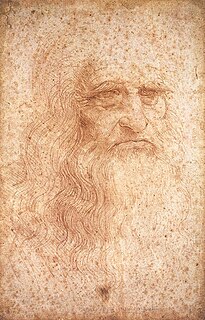
The portrait of a man in red chalk in the Royal Library of Turin is widely, though not universally, accepted as a self-portrait of Leonardo da Vinci. It is thought that Leonardo da Vinci drew this self-portrait at about the age of 60. The portrait has been extensively reproduced and has become an iconic representation of Leonardo as a polymath or "Renaissance Man". Despite this, some historians and scholars disagree as to the true identity of the sitter.
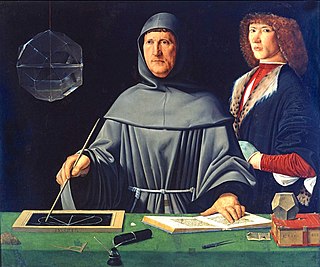
The Portrait of Luca Pacioli is a painting attributed to the Italian Renaissance artist Jacopo de' Barbari, dating to around 1500 and housed in the Capodimonte Museum, Naples, southern Italy. The painting portrays the Renaissance mathematician Luca Pacioli and may have been painted by his collaborator Leonardo da Vinci. The person on the right has not been identified conclusively, but could be the German painter Albrecht Dürer, whom Barbari met between 1495 and 1500.

Salvator Mundi is a painting by Italian Renaissance artist Leonardo da Vinci dated to c. 1500. Long thought to be a copy of a lost original veiled with overpainting, it was rediscovered, restored, and included in a major Leonardo exhibition at the National Gallery, London, in 2011–12. Christie's claimed just after selling the work that most leading scholars consider it to be an original work by Leonardo, but this attribution has been disputed by other specialists, some of whom posit that he only contributed certain elements.

The Leonardeschi is the large group of artists who worked in the studio of or under the influence of Leonardo da Vinci. In 1472 Leonardo joined the Guild of St Luke and at the end of 1477 he left the studio of Andrea del Verrocchio as an independent artist. In 1482 Leonardo came to Milan where he stayed with Giovanni Ambrogio de Predis, Evangelista de Predis and their four brothers, who all were artists of different kinds. Both Predis brothers are known for having collaborated with Leonardo da Vinci in the painting of the Virgin of the Rocks for the altarpiece in the chapel of the Confraternity of the Immaculate Conception at the Church of San Francesco Grande, Milan. In 1490 Leonardo earned recognition and a breakthrough at the court of Ludovico Sforza and because of the scale of works commissioned he was permitted to have assistants and pupils in his own studio.
References
- ↑ "Perspective Machine", The New and Complete American Encyclopedia, John Low, 1810, p.441
- ↑ John Montague, Basic Perspective Drawing: A Visual Approach, John Wiley & Sons, 2013, ISBN 1118414128
- ↑ Leonardo da Vinci, Codex Atlanticus, 1510, reproduced in R. John Williams, The Buddha in the Machine: Art, Technology, and the Meeting of East and West, p.2, ISBN 0300194471
- ↑ Daniele Barbaro, La pratica della perspettiva di Monsignor Daniel Barbaro , Venice, 1559, p. 191, accessed 2016-02-08
- ↑ "Drawing - The discovery of perspective", Heinz Nixdorf Museums Forum, accessed 2016-02-08
- ↑ Perspective machine by James Watt , Science Museum, London, accessed 2020-05-14
- ↑ Watt, James, "Description of a New Perspective Machine", Edinburgh Philosophical Journal, Volume 2, Number 4, Plate 7; Pages 259-262
- ↑ Alexander Dick, Theory and Practice in the Eighteenth Century: Writing Between Philosophy and Literature, Routledge, 2015, ISBN 1317314530. Dick says that the machine was based on Watt's invention but this contradicts the 1765 date given by Watt himself in Description of his Perspective Machine.
- ↑ Ronalds, B.F. (2016). Sir Francis Ronalds: Father of the Electric Telegraph. London: Imperial College Press. ISBN 978-1-78326-917-4.
- ↑ "Perspective Drawing Instruments". Sir Francis Ronalds and his Family. Retrieved 11 Apr 2016.